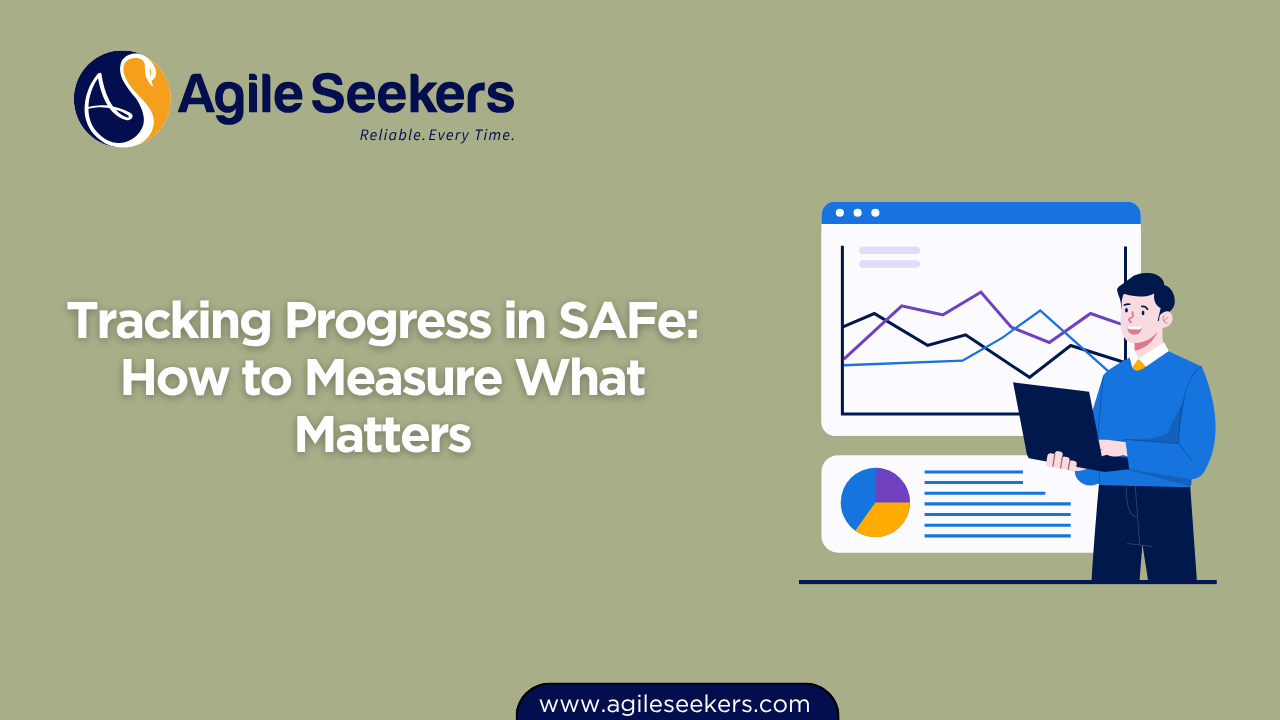Tracking Progress in SAFe: How to Measure What Matters

Measuring progress in SAFe isn’t about tracking every deliverable. It’s about capturing value. Organizations often fall into the trap of focusing on velocity or output, assuming those equate to business results. But SAFe encourages a more strategic approach—one that ties measurement to outcomes, alignment, and flow.
This post breaks down how to track what truly matters in a SAFe transformation—without getting lost in metrics that don’t move the needle.
1. Shift Focus from Outputs to Outcomes
Teams frequently measure productivity using output-based metrics like story points completed, velocity, or number of features delivered. While these metrics provide some insight into execution, they don’t reflect whether the work delivered actual value to the business or customer.
SAFe emphasizes measuring business outcomes—such as improved customer satisfaction, reduced lead time, higher quality, and better employee engagement. These metrics reflect the impact of the work, not just the work itself.
Example: If a team delivers 20 user stories, but customers don’t adopt the functionality, what have you truly achieved?
2. The Role of PI Objectives in Tracking Progress
Program Increment (PI) Objectives are central to measuring success in SAFe. Teams define SMART objectives at the beginning of each PI and assign business value scores in collaboration with Business Owners. These scores help measure actual value delivery at the end of the PI.
The comparison between Planned vs. Actual Business Value reveals whether the team delivered what truly mattered. It also drives transparency and continuous improvement across the Agile Release Train (ART).
This approach is reinforced in the Leading SAFe certification, where participants learn how to connect objectives with value delivery.
3. Measuring Flow Metrics to Monitor System Health
SAFe’s Flow Framework offers a powerful way to assess how value moves through the system. These metrics give visibility into delays, bottlenecks, and overburdened teams. Key flow metrics include:
| Metric | What it Measures |
|---|---|
| Flow Velocity | Number of work items completed over time |
| Flow Time | Time taken from start to finish of a work item |
| Flow Load | Number of items currently in progress |
| Flow Efficiency | Ratio of active work time vs. total elapsed time |
| Flow Distribution | Type of work (features, enablers, defects, debt) |
A Certified SAFe Product Owner/Product Manager (POPM) should regularly analyze these metrics to ensure features align with strategic goals.
4. Align Metrics with Strategic Themes and OKRs
Progress at the team level should ladder up to business strategy. SAFe recommends using Strategic Themes and Objectives and Key Results (OKRs) to guide this alignment.
By linking team-level PI Objectives with enterprise OKRs, leaders ensure teams work on what matters most.
This approach to alignment is reinforced in SAFe Advanced Scrum Master training, where Scrum Masters learn how to coach teams toward system-level thinking.
5. ART-Level Progress: Use Metrics at Scale
At the Agile Release Train (ART) level, metrics should evaluate how well teams deliver on collective commitments and business value. Use tools like:
- Cumulative Flow Diagrams (CFD) to visualize workflow stability
- PI Burnup Charts to track scope and progress
- Predictability Measure (actual vs. planned business value)
These system-level views help SAFe Release Train Engineers (RTEs) identify areas of concern across teams and maintain alignment with enterprise objectives.
Explore more from Scaled Agile’s metrics guidance.
6. Incorporating Customer-Centric Measures
SAFe promotes the use of customer-centric metrics such as:
- Customer Satisfaction (CSAT)
- Net Promoter Score (NPS)
- Feature Adoption Rate
- Support Ticket Trends
These metrics indicate whether the features delivered truly resonate with users. Scrum Masters trained through SAFe Scrum Master Certification often play a role in collecting and communicating this feedback.
7. Lean Budget Guardrails and Value Delivered
Tracking spend without context can be misleading. SAFe encourages Lean Budget Guardrails to ensure that money is being spent on high-value work. Guardrails help in:
- Evaluating epic progress vs. investment
- Supporting participatory budgeting
- Validating alignment to value streams
Measuring cost of delay or return on investment against delivered outcomes adds another layer of accountability.
8. Leading Indicators vs. Lagging Indicators
Progress tracking should include both leading indicators (which help predict outcomes) and lagging indicators (which measure what already happened). Examples:
| Leading Indicators | Lagging Indicators |
|---|---|
| Team engagement scores | Business value achieved per PI |
| Feature cycle time | Customer satisfaction scores |
| % of enabler work completed | Epic completion vs. plan |
| Cross-team dependency resolution | ART-level predictability |
9. Governance Without Bureaucracy
Progress measurement in SAFe isn’t about micromanagement. It’s about lean governance—monitoring the flow of value while enabling autonomy at the team level.
Dashboards and tools should serve teams, not burden them. Metrics should spark conversations, not fear.
The SAFe Scrum Master and Advanced Scrum Master certifications help practitioners coach teams to adopt lightweight but effective governance practices.
10. Drive Improvement through Inspect and Adapt
The Inspect & Adapt (I&A) event is where SAFe organizations evaluate progress objectively and use metrics to fuel retrospectives and problem-solving.
During I&A:
- Teams present PI performance based on business value
- Metrics are reviewed at system and ART level
- Improvement items are identified and actioned
Using this feedback loop, teams don’t just measure—they improve.
Final Thoughts
Measuring progress in SAFe isn’t about tracking everything—it’s about tracking the right things. If your metrics don’t connect to outcomes, flow, or strategy, they’re just noise.
A well-trained team, aligned through roles like Leading SAFe Agilists, POPMs, Scrum Masters, and RTEs, ensures your SAFe implementation delivers measurable, meaningful business results.
For deeper understanding of metrics-driven transformation, explore external guides like SAFe’s Measure and Grow Toolkit.
Also read - Why Outcome-Based Metrics Are Critical in SAFe Transformations
Also see - Metrics That Matter: Monitoring Transformation Results in SAFe




















